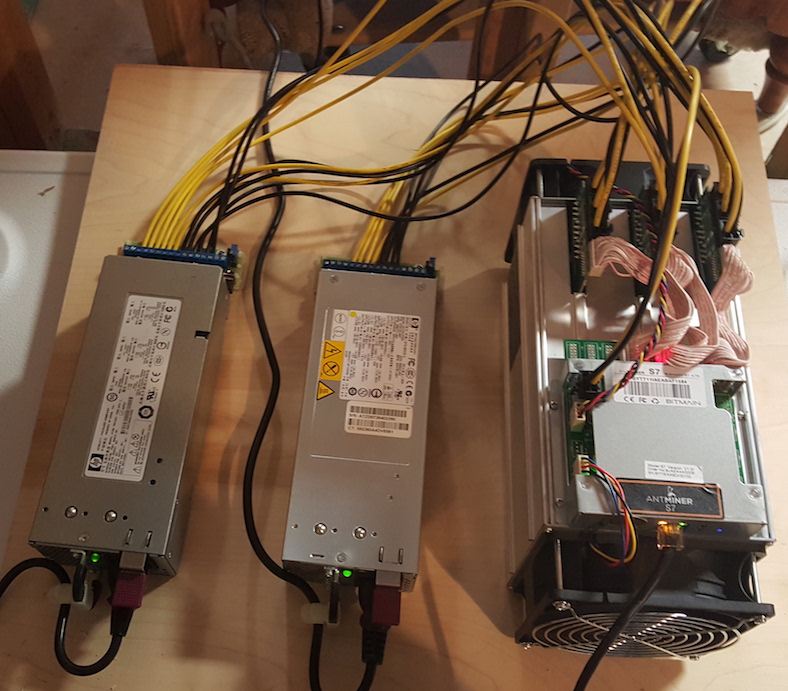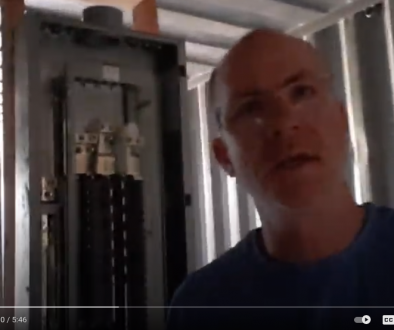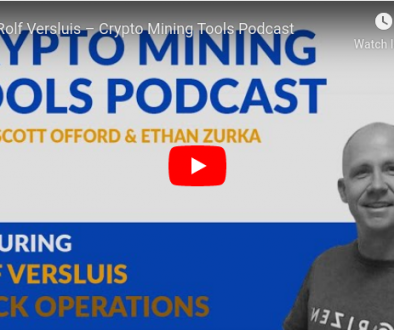Bitcoin mining at home with the Antminer S7
It was easy to order the Bitcoin miner. I just went to the Bitmain website and ordered it. I paid for it in Bitcoin, because a few weeks earlier I had signed up on Coinbase, converted a little money to Bitcoin, and had some ready to go. Getting it running was a little tougher…
I almost ordered a power supply from Bitmain for the miner also, but noticed it was for 220VAC, which I don’t have handy at my house. I thought the power part would be easy. It wasn’t really, and it took some searching to figure out a safe solution that would work.
If you want to use more than one Bitcoin miner, you need to put them in a datacenter, or some other industrial location that can provide the right amount of power and cooling. It’s about 1200 Watts at 220-240 VAC per miner. That gets you about 5000 Gigahash/second, which in early 2016 should enable you to earn about 1 Bitcoin per month as part of a mining pool.
I figure in the winter the power is going to cost me about $50/month, and in the summer about $100/month. Our power company here in the Atlanta area has different rates for the seasons. I thought I would be able to run the miner in the basement, but the noise from the fans has forced it to be placed in the garage.
The most common recommended way to power these boxes off 120VAC is using old server power supplies. There are old HP server power supplies available for about $50 each, and they can each supply up to 1000 Watts at 12 VDC. Dealing with this much power, I didn’t want to just solder some wires to the outputs and short the on/off jumper, so I found what I thought was going to be an ideal solution, a Gigampz breakout board. Unfortunately they were out of stock. And the eBay sellers that said they had them didn’t ship them…it took a few weeks to figure that one out.
So I had this bitcoin miner sitting unused for almost a month! Fortunately I found another breakout board supplier, Centrix power. I had already ordered the 12 PCI-E power cables on eBay, so I had them ready. If you want to get the whole power kit fully assembled, including the power supplies, just get it here. You can also find just the parts you need on their website. This is what it looked like when I connected them.

I connected the PCI-E power cables to the Centrix power boards, plugged them into the power supplies, and plugged the powers supplies into AC power. Success! the green LED came on and the power supply cooling fans started spinning. I connected 6 PCI-E cables to one power supply and 4 to the other, because the Antminer S7 is very specific about power variations. 2 of the boards would get powered from one of the power supplies, with the third board and controller getting powered by the other.

Next I put them on an old piece of plywood, connected up the Antminer S7, plugged one power supply into a wall outlet, and the other power supply into a wall outlet fed by a different circuit breaker. I did not want to plug both into one, pull 10 amps on one circuit, and pop the breaker. Or worse yet, have it overheat something and pop later while I was not there.
I connected the Ethernet port on the S7 directly to the network switch, and powered the system on. It waited for a minute while the controller board booted, then cranked the system fans to max power. Wow it was loud!

There is some kind of app to find out the IP address of the Antminer, but I just looked on the DHCP server of my router and found it. Opening up the control page by typing the IP address directly into the browser, I had access. Thing were looking good. Now to start mining.
I went to the Antpool website, set up a username for the S7, and configured the AntMiner to do stratum mining, which seems like a decent way of going about things. After about 10 minutes or so I could see my Antminer registered to the Antpool, so I let it run for a while. It was mining at a little over 0.001 Bitcoin per hour. With really rough calculations, that seems like it should scale up to 1 Bitcoin per 1000 hours. If I ran it non-stop, that’s about 9-10 Bitcoins per year.

Everyone in the house was complaining about the noise, so I dug up an old Wifi to ethernet gaming client designed for standalone operation and got it working again. I moved everything out to the garage, ran an extension cord for one of the power supplies so I did not overload the house electric circuits, and started everything up again. Success!
Now that I had one of them running, I started thinking about running a second one somehow. And since I have been buying some stuff on Ebay and Amazon from other sellers lately, I thought maybe someone might have bought an Antminer S7 then decided to sell it. And I was correct. There are people selling new and slightly used Antminer S7’s on Amazon..
With really rough calculations…if I can mine about one Bitcoin a month and sell it for $350, and pay $50-100 for power, that leaves maybe $250 in profit. Considering an Antminer S7 and power supply costs $1700, that is about a six month payback. After that it is $250 per Antminer per month profit. Of course, the Bitcoin halving happens next summer. I don’t know how that is going to affect things either.
So this ended up being a typical experiment. Get an idea, try it out, make mistakes, and find out it could have been done much better. But that’s also what always happens. Unless you try it out, you’ll never learn. Maybe I’ll end up selling my Antminer S7 on Amazon after the experiment is over. At least there is a market for it!




